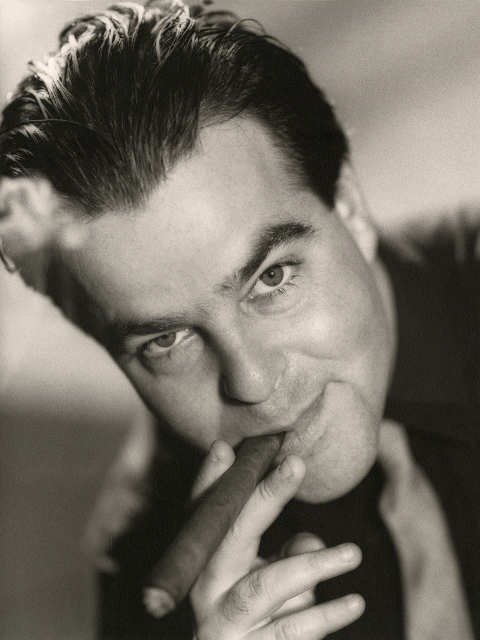
Hollywood is sinking its fangs into Adam Parfrey’s bloody books
By Michael Collins
Los Angeles magazine – January 1998
AFTER A FOUR-YEAR SABBATICAL IN Portland, Oregon, Adam Parfrey has brought his twisted Feral House imprint back to Los Angeles for, as he puts it, “front row seats to the apocalypse.” Until then, he plans to keep turning out the kind of books that brought on the demise of Sodom and Gomorra. A lovelorn racist murderer, a sex cult composed of the physically challenged and gothic millennial prophecy fill Cult Rapture, a recent release of Parfrey’s Feral House publishing company.
Parfrey is best known for editing Apocalypse Culture, a compendium of medical deformities; the pensées of a woman who had sex with cadavers in a Sacramento funeral home; quotations from Hitler and schizophrenic poetry. The book has sold close to 50,000 copies. “The kinds of things I publish do not attract government grants,” says Parfrey from his home office in Venice. His persona is hypnotic: He tends to speak in a discomfiting monotone, his lurid green eyes unblinking. His shock of thick black hair is greased back some days; on other occasions it explodes upward Eraserhead style. “I must push the envelope, go where the big New York boys don’t hang out.”
Parfrey pushed the envelope of utter depravity last year with Death Scenes: A Homicide Detective’s Scrapbook, a gory photographic collection of Los Angeles murders and suicides and a one-car accident that left the driver’s severed head resting upright in the middle of a lonely dirt road. The book has been banned in several libraries in the United States and seized in England, but the American Police Hall of Fame & Museum in Miami sells Death Scenes in its library. The National Association of Chiefs of Police tersely deflects criticism of the work: “I often wonder if those who made complaints are the same folks who slow down at shooting or accident scenes,” says board member Gerald S. Arenberg.
Feral House isn’t just for looky-loos anymore; Hollywood studios are colliding with each other for Parfrey’s macabre material. United Artists hounded him for a look at Jim Hogshire’s Grossed-Out Surgeon Vomits Inside Patient, the just-published insider’s look at tabloid journalism. “They call me every day wanting a copy,” Parfrey says. Touchstone Pictures has expressed interest in The Octopus: Secret Government and the Death of Danny Casolaro, the story of the journalist who died mysteriously in 1991 while investigating a network of far-fetched “conspiracies,” from Area 51 to the human-genome project. Phoenix Pictures has even jumped into the Parfrey arena by paying $100,000 for the rights to Snitch: Confessions of a Tabloid Spy, Computer Hacker and All-Around Scoundrel, another Feral House book about sensational journalism. Parfrey sees the mainstream fixation with his books as a cryptic sign of the times. “During the Depression, people watched Buster Keaton to make them feel good. Maybe now that we’re in a good economic period, you’ve got to torture people with weird stuff.”
A Hollywood movie won’t be much of a stretch for Parfrey, who crosses into new media as readily as he crosses the line of decency. His stage adaptation of Alfred Jarry’s Ubu at UC Santa Cruz in 1979 resulted in a riot when cast members chucked blood-soaked calves’ brains into the audience. Tortures & Torments of the Christian Martyrs, an exhibition Parfrey curated at La Luz de Jesus Gallery in 1990, featured art by mass murderers. Charles Manson crafted shoestrings to resemble scorpions and various demonic symbols, while John Wayne Gacy’s bright, cartoonish oil paintings depicted the Seven Dwarfs bearing clubs and pickaxes. (In the exhibition catalog, Parfrey referred to inmate contributors as “loathsome criminals”; Gacy responded by vowing to put Parfrey’s head in a box.)
Others would like to see Parfrey shut down his presses. Carl Raschke, religious studies professor at the University of Denver and author of Painted Black: From Drug Killings to Heavy Metal–The Alarming True Story of How Satanism Is Terrorizing Our Communities, asserts that Parfrey hides under the cloak of the First Amendment to promote aesthetic terrorism. “Sick is becoming sicker, weird is becoming weirder,” he says. “There are plenty of entrepreneurs out there right now who are catering to the total dementia of Hollywood.”
This aesthetic terrorism—along with sanguine antigovernment paranoia—has earned Parfrey thousands of disciples worldwide. He recently received an e-mail from a slavish Italian devotee that read: “You are the light in the darkness of political correctness. Adam, I will sell you my soul.” Tyger Kahn, the Transylvanian author of the upcoming illustrated book Blowfish: The Zen Approach to Giving a Great Blowjob, calls Parfrey her guru. “Adam is a saint because—like a saint—he is not thinking of himself, he’s thinking of how he can benefit others,” she says. A Clockwork Orange miscreant Malcolm McDowell is also a fan—understandable, since Parfrey was heavily influenced by Kubrick’s film after first seeing it at the age of 13. Even serial killer Richard “the Night Stalker” Ramirez sings mild Parfrey praise. “He provides an extended view and insight into the world of deviancy and depravity—or maybe just a different lifestyle,” Ramirez writes from his death row cell at San Quentin.
Musical composition is the newest facet of Parfrey’s different lifestyle. He melds techno music with fascist sound bites and other oddities in his state-of-the-art studio. On a recent Saturday afternoon, he twisted mixing-board knobs while a young boy with Down’s syndrome yelped and screamed into a microphone. “The kid’s got pipes. Real ‘tard-core,’” smiled Parfrey from behind a cloud of cigar smoke.
As the performer took a juice break, an assistant peeked into the room and alerted Parfrey to a telephone call from another Hollywood producer shopping for goods.
“The world’s gotten weird,” he said as he headed for the phone, “and the weird have gotten professional.”
ADAM PARFREY
(April 12, 1957 – May 10, 2018)
Share your thoughts on Facebook:












Recent Comments